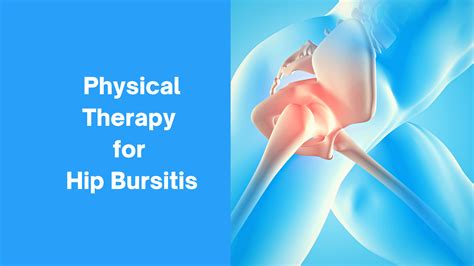Intro
Discover effective Hip Bursitis Treatment Options, including physical therapy, pain relief, and surgical interventions, to alleviate inflammation and restore hip mobility, addressing symptoms and causes of hip bursa inflammation.
Hip bursitis is a common condition that affects millions of people worldwide, causing pain and discomfort in the hip area. The condition occurs when the bursae, small fluid-filled sacs that cushion the joints and reduce friction, become inflamed. This inflammation can be caused by a variety of factors, including repetitive motion, direct blows to the hip, or conditions such as arthritis. Understanding hip bursitis and its treatment options is essential for managing the condition and preventing further complications.
The importance of seeking medical attention for hip bursitis cannot be overstated. If left untreated, the condition can lead to chronic pain, limited mobility, and decreased quality of life. Moreover, hip bursitis can be a symptom of an underlying condition, such as osteoarthritis or rheumatoid arthritis, which requires prompt medical attention. Fortunately, there are various treatment options available for hip bursitis, ranging from conservative management to surgical interventions. In this article, we will delve into the different treatment options for hip bursitis, exploring their benefits, risks, and effectiveness.
Hip bursitis can significantly impact daily life, making it challenging to perform everyday activities, such as walking, running, or even simple tasks like getting in and out of a car. The condition can also affect sleep quality, leading to fatigue, irritability, and decreased productivity. Therefore, it is crucial to seek medical attention if symptoms persist or worsen over time. A healthcare professional can diagnose hip bursitis through a physical examination, medical history, and imaging tests, such as X-rays or MRI scans. Once diagnosed, the healthcare provider can recommend the most suitable treatment option, taking into account the severity of the condition, overall health, and lifestyle.
Hip Bursitis Treatment Options

The primary goal of treating hip bursitis is to reduce inflammation, alleviate pain, and restore mobility. The treatment options can be broadly categorized into conservative management, physical therapy, and surgical interventions. Conservative management involves a combination of lifestyle modifications, medications, and alternative therapies. Physical therapy focuses on exercises and stretches to improve flexibility, strength, and range of motion. Surgical interventions are typically reserved for severe cases or when conservative management fails to provide relief.
Conservative Management
Conservative management is often the first line of treatment for hip bursitis. This approach involves a range of strategies, including: * Rest and ice: Avoiding activities that aggravate the condition and applying ice to reduce inflammation and pain. * Compression: Using an elastic bandage or compression wrap to reduce swelling. * Elevation: Elevating the affected leg above the level of the heart to reduce swelling. * Pain relief medications: Over-the-counter pain relievers, such as ibuprofen or acetaminophen, to manage pain and inflammation. * Physical therapy: Gentle exercises and stretches to improve flexibility and strength.Physical Therapy for Hip Bursitis

Physical therapy plays a vital role in the management of hip bursitis. A physical therapist can design a personalized exercise program to improve flexibility, strength, and range of motion. The exercises may include:
- Stretching: Gentle stretches to improve flexibility and reduce stiffness.
- Strengthening: Exercises to strengthen the muscles around the hip joint, such as the gluteals and hip flexors.
- Mobility exercises: Exercises to improve range of motion and reduce stiffness.
- Balance and proprioception exercises: Exercises to improve balance and proprioception (awareness of body position).
Surgical Interventions
Surgical interventions are typically reserved for severe cases of hip bursitis or when conservative management fails to provide relief. The surgical options may include: * Bursectomy: Surgical removal of the inflamed bursa. * Hip arthroscopy: A minimally invasive surgical procedure to remove inflamed tissue or repair damaged tendons or ligaments. * Open surgery: A traditional open surgical procedure to remove inflamed tissue or repair damaged tendons or ligaments.Alternative Therapies for Hip Bursitis

Alternative therapies can be used in conjunction with conservative management and physical therapy to manage hip bursitis. Some alternative therapies that may be beneficial include:
- Acupuncture: A traditional Chinese medicine technique that involves inserting thin needles into specific points on the body to stimulate healing and reduce pain.
- Massage therapy: A manual therapy that involves manipulating soft tissue to reduce pain, inflammation, and stiffness.
- Chiropractic care: A holistic approach that involves spinal manipulation and other techniques to improve joint mobility and reduce pain.
Lifestyle Modifications
Lifestyle modifications can play a significant role in managing hip bursitis. Some lifestyle modifications that may be beneficial include: * Maintaining a healthy weight: Excess weight can put additional stress on the hip joint, exacerbating the condition. * Avoiding aggravating activities: Avoiding activities that aggravate the condition, such as running or jumping. * Improving posture: Maintaining good posture to reduce stress on the hip joint. * Getting regular exercise: Engaging in regular exercise, such as walking or swimming, to improve flexibility and strength.Preventing Hip Bursitis

Preventing hip bursitis is essential to avoid the condition or reduce its severity. Some strategies that may help prevent hip bursitis include:
- Maintaining a healthy weight: Excess weight can put additional stress on the hip joint, increasing the risk of developing hip bursitis.
- Engaging in regular exercise: Regular exercise can help improve flexibility and strength, reducing the risk of developing hip bursitis.
- Avoiding repetitive activities: Avoiding repetitive activities, such as running or jumping, can reduce the risk of developing hip bursitis.
- Wearing proper footwear: Wearing proper footwear, such as shoes with good arch support, can reduce the risk of developing hip bursitis.
Managing Hip Bursitis in Different Populations
Hip bursitis can affect different populations, including athletes, older adults, and individuals with underlying medical conditions. Managing hip bursitis in these populations requires a tailored approach, taking into account their unique needs and circumstances. For example: * Athletes: Athletes may require a more aggressive treatment approach, including physical therapy and alternative therapies, to manage hip bursitis and prevent further injury. * Older adults: Older adults may require a more conservative approach, focusing on pain management and lifestyle modifications, to manage hip bursitis and prevent further complications. * Individuals with underlying medical conditions: Individuals with underlying medical conditions, such as diabetes or rheumatoid arthritis, may require a more comprehensive approach, including medication management and lifestyle modifications, to manage hip bursitis and prevent further complications.Current Research and Developments

Current research and developments in the field of hip bursitis are focused on improving treatment options and preventing the condition. Some areas of research include:
- Stem cell therapy: Researchers are exploring the use of stem cells to repair damaged tissue and promote healing in hip bursitis.
- Platelet-rich plasma (PRP) therapy: Researchers are investigating the use of PRP therapy to promote healing and reduce inflammation in hip bursitis.
- Gene therapy: Researchers are exploring the use of gene therapy to modify the genes responsible for hip bursitis and prevent the condition.
Conclusion and Future Directions
In conclusion, hip bursitis is a common condition that requires prompt medical attention to prevent further complications. The treatment options for hip bursitis range from conservative management to surgical interventions, and alternative therapies can be used in conjunction with these approaches. Lifestyle modifications, such as maintaining a healthy weight and avoiding aggravating activities, can also play a significant role in managing hip bursitis. Future research and developments are focused on improving treatment options and preventing the condition, and it is essential to stay informed about the latest advancements in the field.What are the symptoms of hip bursitis?
+The symptoms of hip bursitis include pain and tenderness in the hip area, swelling and redness, limited mobility, and stiffness.
How is hip bursitis diagnosed?
+Hip bursitis is diagnosed through a physical examination, medical history, and imaging tests, such as X-rays or MRI scans.
What are the treatment options for hip bursitis?
+The treatment options for hip bursitis include conservative management, physical therapy, and surgical interventions, as well as alternative therapies, such as acupuncture and massage therapy.
Can hip bursitis be prevented?
+Yes, hip bursitis can be prevented by maintaining a healthy weight, engaging in regular exercise, avoiding repetitive activities, and wearing proper footwear.
What are the complications of hip bursitis?
+The complications of hip bursitis include chronic pain, limited mobility, and decreased quality of life, as well as an increased risk of developing other conditions, such as osteoarthritis or rheumatoid arthritis.
We hope this article has provided you with a comprehensive understanding of hip bursitis and its treatment options. If you have any questions or concerns, please do not hesitate to comment below. Share this article with your friends and family to help raise awareness about hip bursitis and its importance. Take the first step towards managing hip bursitis and improving your overall health and well-being.
